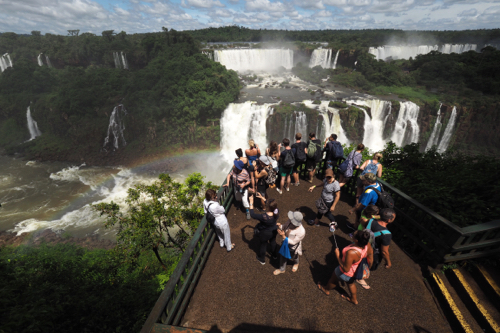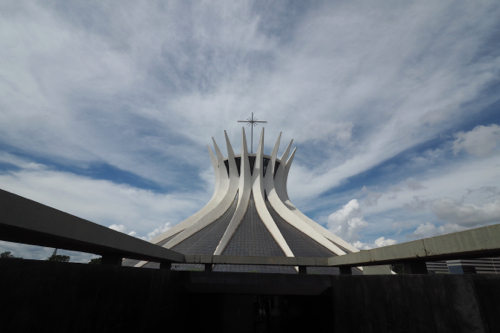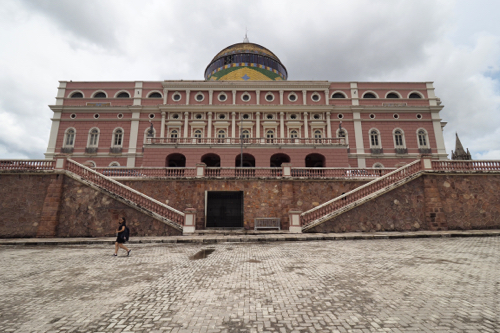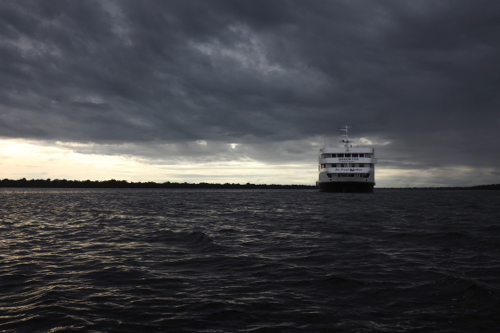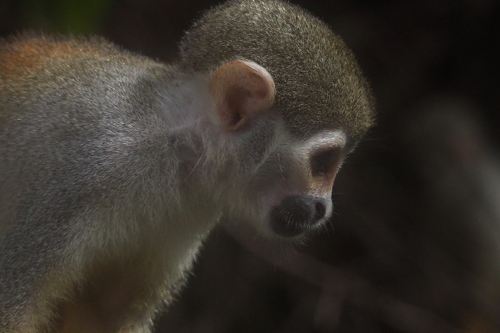February 27, 2018. Puerto Iguazú, Argentina to Foz do Iguaçu, Brazil.
Today we were crossing the border into Brazil, the last new country on this trip.
We walked the kilometre or so into town to get money and try and find a coffee.
We then took the long way back to the hotel along the Iguazú River.
It had been raining and was now hot and steamy, we haven’t had tropical weather for a long time.
Puerto Iguazú is a very tired and rundown looking place. It suffers from the fact that all the big hotels, catering to the many tourists, are out of the town centre.
They are mainly self sufficient and the punters have no reason to come into town.
Also many of the restaurants in the town centre only open at lunchtime and not in the evening, when the tourists normally eat.
During the middle of the day the tourists are visiting the falls.
Crossing the border was very easy. The hotel booked us a taxi and he took us from Puerto Iguazú to our hotel in Foz do Iguaçu, Brazil.
The immigration leaving Argentina was at a kiosk, where we didn’t even have to get out of the taxi.
We went over the Tancredo Neves Bridge (1985) and crossed in Brazil.
Our biggest problem was remembering our limited Portuguese.
When we arrived at the Viale Tower Hotel it started to rain again. Once it cleared we had a wander around the town area close to our hotel. We also needed to get some Brazilian Reals so needed a bank. There were none open so we ended up a a money changer.
February 28, 2018. Foz do Iguaçu and Iguaçu Falls, Brazil.
We took Public bus number 120 to the Iguaçu National Park.
It was a slow 14 kilometres.
There were evacuation signs on the emergency exit, which had a number of graphics showing who had priority. Obese people were first, which was a sure signal that obesity is part of life in Brazil, as it is in much of Central and South America.
We were in Foz do Iguaçu to view the Iguaçu Falls from the Brazilian side – it was a very different experience.
There were fewer people and the experience seemed less hectic.
From the visitor’s centre we caught a double decker bus down to the falls and from there we walked around the Devil’s Throat, this time viewing it from the Brazilian side.
We put on our wet weather ponchos (plastic bags) and ventured out into the mist.
The walk to get there is pleasant, with many viewing points along the way.
The Iguaçu National Park, created in 1939, was made a UNESCO World Heritage site in 1986. It has an area of 185,262 hectares and borders the Argentinian side of the falls. Together the two National Parks are about 260,000 hectares in area.
In the end we decided that it was really worth seeing the falls from both sides.
In the afternoon we crossed over the road, from the National Park entrance and into Parque das Aves.
This Bird Park has a wide variety of tropical birds, with many of them being rescued from smugglers. A highlight was seeing the Tocu Toucans. The park was opened in 1994 and is about 16 hectares in size.
March 1, 2018. Foz do Iguaçu, Brazil.
Having now visited the falls on both sides we decided to do something completely different.
The Itaipu Binacional is a huge dam and reservoir, on the Paraná River, just outside of Foz do Iguaçu. The dam has a volume of 12,300,000 cubic metres.
The name Itaipu was taken from an island that was near the construction site and means ‘sounding stone’ in the local Guarani language.
It’s a joint project between Brazil and Paraguay. Construction starting in 1974 and was completed in 1991.
It has 20 generators producing 103,098,366 megawatt hours of electricity, more than any other dam in the world. Ten generators produce electricity for Brazil and the other ten for Paraguay. Interestingly the Paraguayan generators produce more than the country needs so they sell it back to Brazil.
March 2, 2018. Foz do Iguaçu to Brasilia, Brazil.
Most of the day was spent travelling, as we were off to Brasilia. Unfortunately there were no direct flights so we had to go via Sao Paulo.
I have come to the conclusion that budget airlines are fooling themselves by putting profit before people.
Good evidence of this was our flight to Brasilia. We were charged Brazilian Real 80 (A$30+) each to check our bags into the hold. It was cheaper if we had done it online. However it wouldn’t accept our international credit card.
This exorbitant cost means that most passengers opt to pack everything into their cabin baggage.
They are often larger than the official size. Then some passengers even carry two bags, where they should only have one.
Just prior to boarding there was an announcement asking if passengers would like to check in their hand luggage – at no charge.
There were a few takers with most opting to take their cabin bags on board. They then had to fight for overhead locker space.
Then there’s a repeat of the bun-fight once you land.
Now everyone, who was forced to put their bags in lockers that were behind their seats, had to scramble to get them. They usually do this before the seatbelt sign is turned off, causing more confusion.
If the airlines didn’t charge, there wouldn’t be a problem and flights would be much more enjoyable, for everyone.
But then the airlines wouldn’t make extra profit by carrying cargo. Which, to them, is far more important than the safety and comfort of their passengers.
There needs to be a point where business has to balance their profits over the well-being of the consumers and their staff.
That night we ate at Coco Bambu in Brasìlia Shopping, a mall just over the road from our hotel, the Culling Hplus Premium.
It was a very pleasant restaurant with great staff. They didn’t speak English but alerted us to the fact that we had ordered too much.
How many restaurants do that?
March 3, 2018. Brasilia, Brazil.
Brasilia is the capital of Brazil and situated in the Brazilian highlands. It’s a modern city, purpose built to be the nations capital, much like Canberra in Australia.
Founded in 1960 it is now Brazil’s third largest city. The city was planned and developed in 1956 by the urban planner, Lúcio Costa and the modernist architect Oscar Niemeyer.
We were in Brasilia for the architecture.
The hotel booked us a day tour and we hoped that we would get to see some of the most famous buildings. Our guide was Ira and our small group raced around trying to get a feel for this most contemporary of cities.
In 1987, only 27 years after its foundation, Brasilia was declared a UNESCO World Heritage Site. It is the youngest city in the world to be given that honour.
Some of the building we visited were; Mané Garrincha Stadium (1974), Juscelino Kubitschek Mausoleum (1960), Dom Bosco Church (1970), Our Lady of Aparecida Metropolitan Cathedral (1970), National Congress Building (1970), The Three Powers Square and the Alvorada Palace (1957).
The highlight for me was the JK (Juscelino Kubitschek) Bridge, constructed in 2002 and based on the idea of a pebble skipping over a pond.
Concrete cancer is the scourge of Brasilia.
It is a particular problem with modern, reinforced steel and concrete buildings. The steel begins to rust within the concrete causing it to expand. It then becomes brittle and cracks and in some cases falls from the structure.
Evidence of concrete cancer is everywhere in Brasilia. There has been some restoration but much more is needed, especially considering the cities heritage listing.
The day was marred by us both getting a touch of food poisoning.
Ira suggested that we all go and have lunch at a local Brazilian restaurant. It was the kind that you only pay for what you eat. You select what you want and then they weigh it.
There was obviously something in what we chose that we didn’t intend to get.
For the rest of the afternoon and the night we felt very sorry for ourselves.
No dinner that evening.
March 4, 2018. Brasilia to Manaus, Brazil.
Felling better but not yet over our upset stomachs, we were grateful that we had arranged a late check-out.
The only flight we could get to Manaus, on the Amazon, was at 11:30pm so a day to ourselves in the hotel was welcome.
We did return to Brasìlia Shopping and had a light lunch but that was about the extent of our travels and our food intake.
March 5, 2018. Manaus and the Amazon, Brazil.
After checking into our Manaus hotel at 3am we tried to get a few hours sleep.
After a late breakfast we went for a walk around the town.
As we came out, the rain came down.
We were on the Amazon and 3° south of the equator so it was to be expected.
The main feature of Manaus, apart from being the gateway to the Amazon, is the Amazon Theatre.
The Amazon Theatre was built in 1896 during the ‘Belle Époque’ period of the rubber boom. It was designed in the Renaissance Revival style by the Italian architect Celestial Sacardim. The dome is covered with 36,000 ceramic tiles painted in the colours of the Brazilian national flag.
Manaus is the capital city in the Brazilian state of Amazonas. It is on the confluence of the Negro and Solimões rivers. It was founded in 1669 as the Fort of São José and became a town in 1832.
Manaus is slap bang in the middle of the Amazon rain forest and the embarkation point for boat trips into the Brazilian Amazon. Which is exactly what we had planned to do.
Part of the afternoon was spent trying to book our return flight to Australia.
We have used LATAM Airlines a lot in South America and found that they were the fastest and most economical way to return to Australia.
Booking this trip wasn’t without its issues.
As I have winged about before, nothing comes free with these low cost airlines.
That’s fine if you can work out how to actually pay for the extras.
Thea spent an hour trying to pay for our seats on the trans Pacific leg from Santiago to Melbourne but couldn’t get the credit card to work. She even phoned the help desk and they were no help at all.
After battling unhelpful help desks, we got a taxi down to the port at 3 pm and checked in to the Iberostar Grand Amazon.
Our cabin on the boat, especially the bathroom, was larger than some hotels we have stayed in. In fact it was more like a hotel suite than a ship’s cabin.
It also had a Nespresso machine and a range of pods.
For a couple who have sworn off ‘cruising’ here we were, on yet another ship, only a month after we were sailing in the Antarctic.
The Iberostar Grand Amazon was sold as an all inclusive tour – meaning everything is included in the price.
Of course there is a caveat on that.
Everything, doesn’t include the two indulgences we enjoy.
Good wine and craft beer.
You could buy wine by the glass, but this was limited to a house red and white, of dubious origin.
There were four beers on offer, all of them Pilsners.
What the!
At dusk the ship headed north west, up the Rio Negro, for our first night on the water.
Compared to the SS Expedition travelling to Antarctica, we were barely moving.
It was hard not to compare the Antarctic trip to this one within the Amazon region.
Both were small ships on an adventure cruise, with a large crew.
However they were very different.
Antarctica was English language oriented while the Amazon was very much Portuguese.
Antarctica was wilderness, wildlife and conservation, while the Amazon was more about the indigenous people, experiences and shopping opportunities.
We didn’t actually sail on the Amazon River until the final morning.
Which in a way was good for me.
Because of the ph balance of the Negro River, apparently mosquitoes don’t breed on the water. They only reproduce in the bromeliads, up in the tree canopy.
Whereas on the Amazon River there is no such issue.
I liked the Negro.
It was a good theory, until a few days later, when I discovered that there still are things that bite on the Rio Negro.
And naturally they found me.
March 6, 2018. The Amazon, Brazil.
In the morning we walked through the Jaraqui Stream area and Luis was our guide.
It wasn’t about animals but about the life, death and regrowth of the Amazon Rainforest.
Everywhere we looked there was dead, dying or decaying plants and new life springing up.
The rain held off for the morning but it looked very threatening for the afternoon.
The itinerary was changed about, as we had to return to Manaus. Apparently one of the generators needed replacing.
They assured us that none of the activities would be effected.
Our afternoon boat trip to Trés Bocas was therefore cancelled and replaced by a visit to Cambebas, an indigenous village.
There was a lunchtime talk about the Amazon Forrest and the effects of the wet season on the water levels, as well as the plant and animal life.
Thea’s technical problems have followed us to the Amazon and are now effecting everything around us.
When we first arrived, our room safe wouldn’t work and needed a new battery. Then our cabin door wouldn’t open and we were locked out.
Even the ship’s breakdowns continued with the outboard engine on our tender dying on the way back from Cambebas Village.
March 7, 2018. The Amazon, Brazil.
The morning adventure was the boat trip to Trés Bocas and this time Jefferson was our guide.
This is part of Anavilhanas, the second largest fluvial archipelago in the world. It’s a huge collection of river islands and beaches.
Tres Bocas is one of the largest islands in the Archipelago.
This trip was more about being on the river and experiencing Amazonia. We saw Toucans, Macaws, Green Parrots as well as Dolphins.
This was all done at a distance and made good photography very difficult. Especially as the cloudy skies caused everything to be backlit .
At one point Jefferson stopped the boat and we just listened to the jungle. It’s too easy to spend time on photography and forget to enjoy the moment.
In the afternoon, as part of the on-board program, there was a talk on the fish of the Amazon.
Entertainment seemed to be a very important part of life on board the Iberostar Grand Amazon.
On our first night, after dinner, there was a magician. Then the staff band performed after dinner on night two and then again at lunchtime on the third day.
The South Americans, especially the Brazilians, love to dance. The performance was definitely aimed at them.
I can see why Carnival is so popular.
There was a group of Germans and they were always holding a drink. They never let go of their glasses during lunchtime, while the band was playing and even when they were in the pool.
They were definitely making the most of the open bar policy.
The afternoon activity was Piranha Fishing.
We decided to participate in this for two reasons. Firstly it was catch and release, so no fish were actually taken and secondly I wanted to see this mythical creature in close-up.
Apart from the thrill of being on the river and in the backwaters it was a frustrating experience.
Firstly it poured down and everything got wet. But worse than that, I didn’t catch a thing.
And I was the only one.
There was yet another performer after dinner. This time it was an indigenous member of staff.
His specialty was flutes and he played at least six different types.
It was cleverly done as a soundtrack to a documentary video about Brazil, the people, culture, animals and land.
This played on a screen behind.
He concluded the short show with his own rendition of John Lennon’s ‘Imagine’
The background video, to this classic song, featured indigenous people from around the word.
It delivered a very powerful and poignant message.
In the evening we went Caiman spotting and only managed to get a glimpse of one reptile scurrying into the water – that was it.
March 8, 2018. The Amazon, Brazil.
We were up at 5:30 am for the sunrise.
The sun didn’t rise but Luis had a surprise for us anyway. He took us to see the Ariaú Jungle Tower, an abandoned eco resort.
When it was operating it had about eight kilometres of elevated walkway through the jungle. The guests could drive golf carts from one part of the resort to the other. There were six tower blocks and 288 rooms elevated over the jungle.
It only closed at the beginning of 2016 and very quickly the jungle has reclaimed the site.
After breakfast we were to visit the Pink Amazon River Dolphins. This was with Jefferson, our guide guide from earlier in the week.
However because of the number of people wanting to do the dolphins trip, we did a nature cruise first.
There were monkeys, sloths and a variety of birds.
We also passed through the abandoned resort again. This time from the other side.
After about ninety minutes we arrived at a small floating platform that was very close to the ship, and our original starting point.
This is an a opportunity to be in the water at the same time the dolphins are being fed.
It is supposedly an eco and environmentally conscious activity. However these are wild animals that now rely on humans for their food and therefore survival.
I was disappointed that Jefferson also fed the monkeys on our way to the dolphins.
It was great for the tourists but not good for the monkeys.
At lunchtime the band played again. They normally only play twice, but it was International Women’s Day and the ladies loved to dance.
The last off-ship experience was to the Rubber Tapping Museum.
This part of the Amazon region was the heart of the wealthy Brazilian rubber industry, during the late part of the 19th Century. This was the golden age for rubber and there was a large expansion of European colonisation in the Amazon Basin. The rubber was extracted from trees in a very random way, as there were no plantations as we now see in South East Asia. The trees were in the jungle and rubber tappers would spend days at a time out tapping the trees. Slavery, murder and brutality were widespread.
The Rubber Barons got rich but at the expense of the indigenous population.
The Vila Parasío Rubber Museum is built within a film set for a Portuguese movie, titled, ‘The Jungle’.
The movie was about these barons and their excesses.
